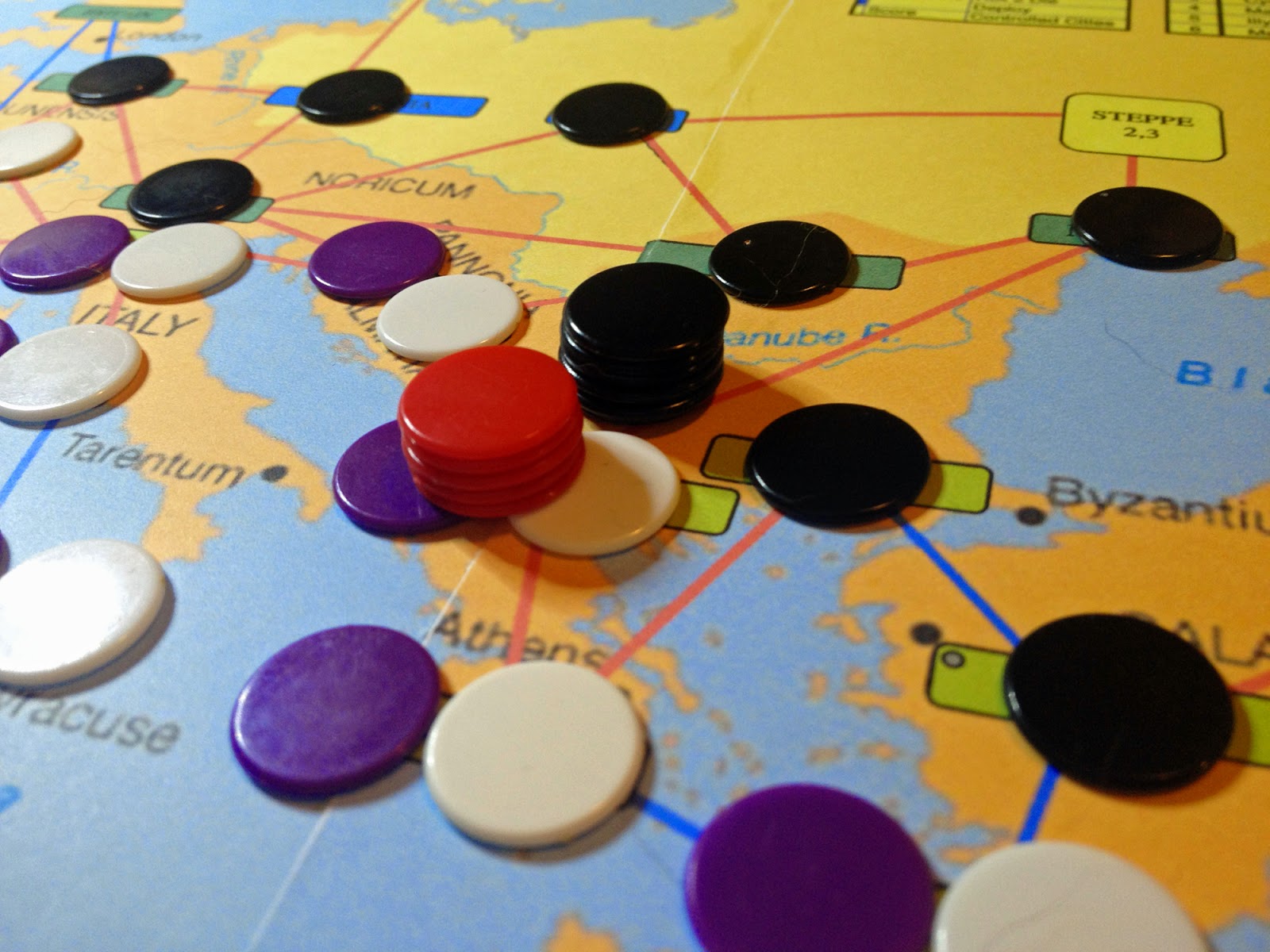Whilst discussing some gladiator stuff by email, Victor mentioned a game he'd been playing called 'Solitaire Caesar', which allowed you to run the rise and fall of Rome - from the Punic Wars to the Fall of Constantinople - in about an hour. It sounded fun and, as a cheap print and play game, easy to get hold off. So I bought and downloaded it, and gave it an outing this evening.
'Solitaire Caesar' is a very simple and abstract game, but fun to play. The map of Europe, North Africa and the Middle east is divided up into provinces, connected by invasion routes. As the Romans you are trying to control these provinces, and build cities in them, with the cities you control being the points you score at the end of each turn. Each turn covers 100 years, and the game lasts 18 turns, from 300BC to 1500AD. At five points around the map are areas which generate Barbarians, who spread out across the map, their advance only being halted by your legions and (sometimes) your controlled cities. The game is weighted in favour of the Barbarians; you can delay them, but never entirely hold them back, so the empire you build in the first few turns slowly crumbles, until you spend the last few turns grimly holding on to a handful of provinces. Whilst there is a guide which gives you a rough outline of who the Barbarians represent from turn to turn, they are simply Barbarians in terms of the mechanics. The only differentiation is that, on some turns, Barbarians generated from certain areas are considered Civilised - this merely means that they don't destroy any cities they capture.
The download includes a PDF of the rules, which includes a map and some counters to be mounted on card and cut out, plus an alternative (larger and clearer) map and a scoresheet. The counters are actually pretty simple - control markers, cities, Legions and Barbarians - so I used coloured counters rather than wasting time with glue and cutting.
On with the game. This was the position after the Roman actions in the first turn. Purple counters show Roman controlled provinces, white counters are cities and red counters are the Legions. The stack of black counters are the first horde of Barbarians - Hannibal's Carthaginians.
There are two waves of Barbarians each turn (generated by a rather elegant mechanism which keeps the broad trends of historical, and therefore predictable, invasions, whilst creating random threats to the Empire as well). In this case whilst I knew I would face the Carthaginians on the first turn, I wasn't prepared for a threat nearly as large on the Steppes (top right of this picture). Whilst they wouldn't directly threaten my current provinces, they would spread out across the map, destroying existing cities and making it harder for me to take new provinces.
And here's the position after the first Barbarian attacks. Northern Europe will be harder to take, and all of my Legions have been wiped out with North Africa and Sicily being under Barbarian control as well.
Still, in Turn 2 I got to expand some more.
And so the game continued. I think I just took this picture around Turn 7 or 8, when a massed horde of Goths rolled in off the Steppes and threatened Greece.
Rome fell to the Barbarians on Turn 9 ...
... leaving the Eastern Empire as the beacon of True Civilisation
Here come the Arabs!
But the province of Egypt saw them off in an epic series of battles.
However the decline is only ever delayed in this game. By Turn 15 the Empire consisted solely of the province of Rhodes.
On Turn 16 Rhodes fell.
My final score was poor - a mere 96. 125 points is considered the lower limit of an Historical result. I never really built much of an Eastern Empire, which seems to be essential, as it's the Western Empire which collapses first and survival depends on having a strong position in the East to fall back on. Some large Barbarian incursions early on in the game made it much harder for the Empire to spread that in reality; my Legions had to fight hard for every square mile of ground.
The game plays quickly; I managed this first game in just over an hour. And then played a second. I didn't take pictures of that, but did a little better, having six consecutive turns where I held 14 or more cities. But decline is inevitable, and by the time the Mongols and Ottomans were on the march the Empire consisted of Alexandria and Jerusalem. Around 1300, Alexandria fell, and the Roman Empire was no more. This time I scored 124 points - still considered Poor, but approaching an historical level of survival.
This is not a game you'll play again and again; it's very luck-based and abstract. But for the money - a mere $5 - it's worth the investment.
You can download it here:
Solitaire Caesar













if you are guaranteed to lose, the only question being how bad a loss, why would you play this game? I try to win games I play. I there is no chance I can win, I don't play. Is there some other attraction to this game?. I understand intermittent reinforcement, but if no reinforcement is possible?
ReplyDeleteYou 'win' by bettering your score in previous games.. There is also a series of graded levels for scores, so you can compare your score against what happened historically - both of my scores were below history, although the second was close.
DeleteThere is always the option for reinforcements; you have to buy them using the money you get at the start of each turn. But the supply of money varies through the game, and gets less as the game goes on. The supply of barbarians encroaching on your empire remains the same.